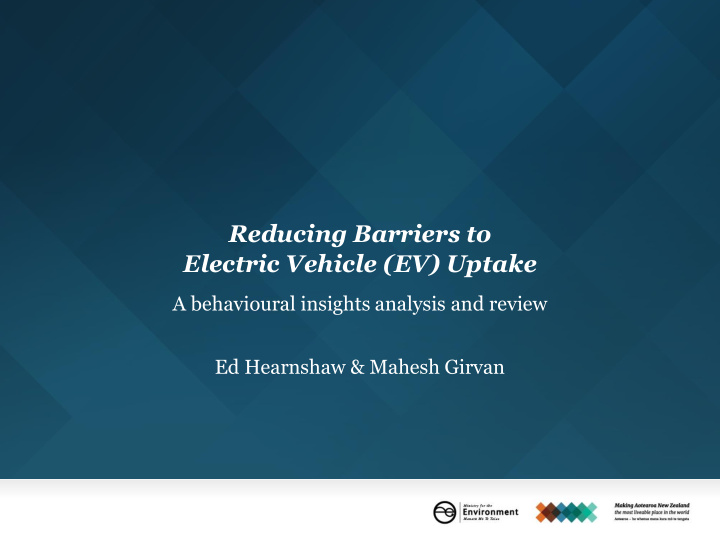



Reducing Barriers to Electric Vehicle (EV) Uptake A behavioural insights analysis and review Ed Hearnshaw & Mahesh Girvan
NZ is EV Ready! • NZ one of the most EV ready countries • Around 80% of electricity from renewable sources • More than 85% of homes have off-street parking to easily charge EVs • In spite of opportunities for EVs, there are many barriers to uptake • Driving range • Charging infrastructure • High purchase price
Our Behavioural Insights Approach Interventions proposed Barrier to electric vehicle Biases behind the barrier from behavioural insight uptake collated from are identified and and transport literature transport literature and inferred from behavioural to reduce biases and placed within the New insights literature potentially overcome Zealand context barrier
Barrier: Driving Range • EVs typically smaller range than ICEV • NZ survey found only 39% think EVs satisfy driving needs • Another NZ survey found cars need to travel 350+kms • But driving range increasing with EVs • Preferred range wildly exceeds need • Gap between perceived & real concerns • Driving range is psychologically driven
Biases: Driving Range • Status quo bias appears strongly linked to driving range concerns • Why? Bias develops from status quo reference point being ICEV range • Status quo bias shaped by loss aversion • Why? Buyers comparing EVs with ICEVs will see shorter range as a loss
Interventions: Driving Range • Perspective taking & widening context can reduce loss aversion • e.g. instead of focusing on EV purchase in isolation, buyers could be reminded that if they own a ICEV they can use that for longer trips • Alternatively could reframe reference point to actual needs • Driving experience with EVs can help reframe reference point to actual needs • Approaches to increase driving experience of EVs include ride-and-drive activities
Barrier: High Purchase Price • Upfront purchase price is consistently identified as the biggest barrier preventing EV uptake • However, recent studies and improving economics show that despite a higher upfront purchase price, lower EV running costs (30 cents per litre) make total ownership or lifetime costs similar. • EVs prices are falling • A potential barrier also related to upfront purchase price is the character of the vehicle market in New Zealand
Biases: myopia and sunk cost fallacy • Myopia (short-sightedness) grounded on hyperbolic discounting • People tend to hold onto vehicles when they should be replaced due to the sunk cost fallacy
Interventions: Research indicates that there are various interventions that can reduce myopia • US EPA – online labelling and vehicle purchasing trends Effective labelling scales: • Clothes dryers in the UK (London Economics, 2014) • Israeli Ministry of Environmental Protection (OECD, 2017) US EPA Vehicle Buying Cycle
Some Final Thoughts • Key barriers to EV uptake are largely psychologically driven • This signifies importance of behavioural insights to address them • Analysis finds that ICEVs & their 100+ year domination has shaped our preferences • Approach effective for policy analysis! i.e. barriers > biases > interventions • Behavioural insights has long promoted RCTs • Critical finding in this work highlights driving experience important to reducing barriers • RCT on NZ driving experience could be very beneficial
Recommend
More recommend